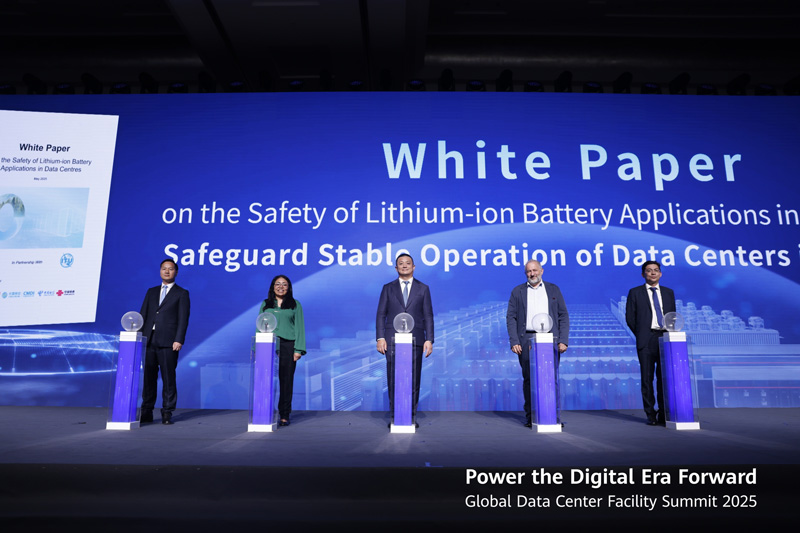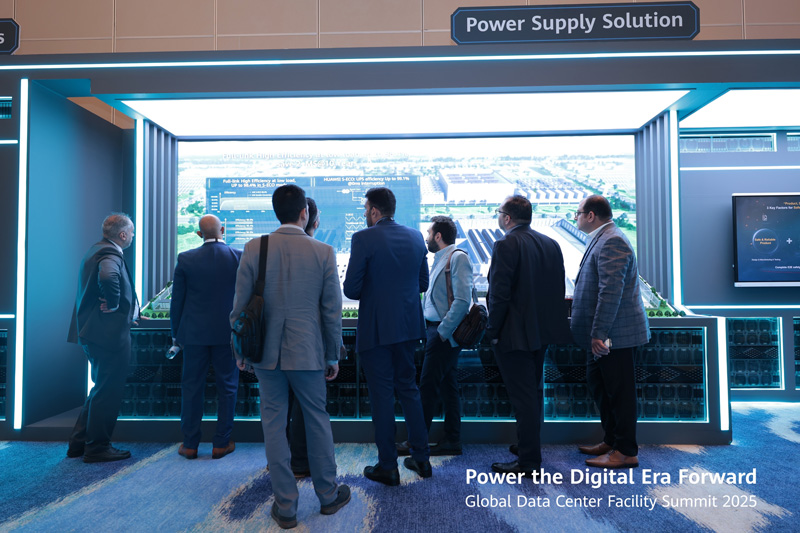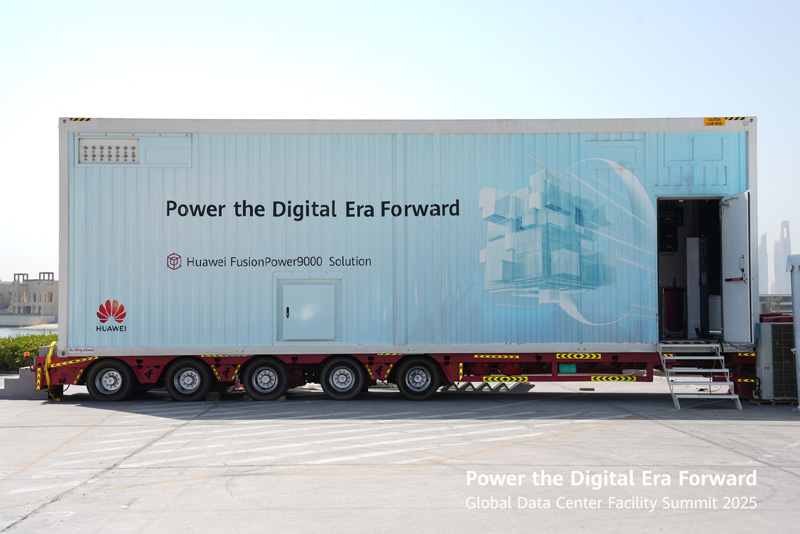On May 13, 2025, the Global Data Center Facility Summit 2025 themed “Power the Digital Era Forward” was held in Dubai, the city of desert. The summit brought together more than 500 intelligent computing industry leaders, technical experts, and ecosystem partners to discuss new growth opportunities and development paths for the data center (DC) industry in the intelligent computing era, and released the AI DC solution, accelerating the industry towards a new era of intelligent computing.
Embracing the Golden Era of Intelligent Computing for a Win-Win Future
Charles Yang, Senior Vice President of Huawei and President of Global Marketing, Sales and Services, Huawei Digital Power, said in his opening speech that the golden era of computing infrastructure has arrived, as AI models are benefiting various industries, and enterprises are enhancing their competitiveness by deploying local AI inference computing platforms. It is estimated that the global AI DC capacity will exceed 100 GW by 2028, generating a market space of over US$600 billion in the energy infrastructure sector alone.

According to Charles, higher reliability, faster rollout, and greater energy demand have become the three major challenges for AI DC development. And Huawei believes that there are three important development trends of AI DCs in the future:
- Improve AI DC reliability through architecture innovation: Reliability is the top priority. A power supply system with an isolated architecture, such as a dedicated prefabricated container or remote deployment, can greatly improve system reliability and ensure stable operation of DCs.
- Accelerate AI DC construction through modular and prefabricated architecture: Huawei’s PowerPOD adopts a fully decoupled architecture to achieve one power system per container. It greatly shortens the time to market (TTM), achieves a prefabrication rate of over 90%, and reduces onsite manpower by 70%.
- Improve AI DC energy efficiency through green power deployment and efficiency optimization: Green power sources can be provided through direct green power supply and PV development in campuses. Energy efficiency of existing DCs can be improved through AI-based energy efficiency optimization.
Building a Robust Foundation for the Intelligent Computing Era
At the summit, Bob He, Vice President of Huawei Digital Power and President of Data Center Facility & Critical Power Product Line, Huawei Digital Power, delivered a keynote speech titled “Building a Robust Foundation for the Intelligent Computing Era”, and released Huawei’s AI DC solution globally, driving the industry towards the intelligent computing era.

As mentioned by Bob, in the intelligent computing era, the AI industry is booming at an unprecedented pace. Although intelligent computing centers are experiencing a surge in construction, they also face challenges such as reliability, rapid delivery, elastic deployment, and low total cost of operations (TCO). In response, Huawei first proposed RASTM, the core principles for AI DC construction.
- Reliable: Reliability is the top priority. The full-lifecycle reliability of AI DCs must be ensured in terms of products, architecture, intelligent management, and professional services. Take Huawei’s lithium batteries as an example. In terms of product, an E2E safety defense line is established at the cell, pack, device, and system levels. In terms of architecture, an isolated architecture is used to minimize the impact of accidents on services. In terms of system, cloud-based proactive prevention and onsite inspection are combined to detect failures early and ensure system safety.
- Agile: AI DCs must be agile from components to the system to flexibly cope with uncertainties in AI services. Huawei’s PowerPOD adopts a fully decoupled architecture and deeply integrates subsystems such as UPSs and lithium batteries. The solution realizes one power system per container and is deployed outdoors, meeting the requirements of on-demand deployment and phased capacity expansion. With a modular design, the PowerPOD is prefabricated and pre-commissioned in the factory, shortening the delivery period from 28 weeks to 18 weeks and accelerating the rollout of AI services.
- Sustainable: In high-density and high-computing power scenarios, the power supply efficiency of AI DCs is even more important. To enhance energy efficiency, it is crucial to prioritize parallel system efficiency over module efficiency and then implement the S-ECO mode on a broad scale. Take Huawei’s modular UPS5000-H as an example. The efficiency of a single UPS and a parallel system is 97.5% and 97.3%, respectively. In S-ECO mode, the efficiency reaches 99.1%, achieving optimal energy efficiency.
With reliable products, full-lifecycle services, and professional consulting and design capabilities, Huawei works with partners to build the AI DC solution, helping construct intelligent computing centers that feature fast delivery, all-domain reliability, optimal TCO, and strong flexibility.
Bob noted that the AI DC solution embodies Huawei’s extensive experience in DC construction and the win-win cooperation of the DC ecosystem. Going forward, Huawei will continue to prioritize technological innovations in the power supply and cooling architectures of next-generation intelligent computing centers, integrate safety and reliability into every aspect of our products, and work with customers, partners, and industry organizations to build reliable, agile, and sustainable AI DCs, and power the digital era forward.

During the summit, Huawei and the International Telecommunication Union (ITU), with the support of Alibaba Cloud, China Mobile Group Design Institute, China Telecom, and China Unicom, jointly release the White Paper on the Safety of Lithium-ion Battery Applications in Data Centres, which systematically describes how to improve the safety of lithium-ion battery applications in DCs from seven dimensions. The White Paper states that the intrinsic safety of lithium-ion batteries must be ensured from three levels: battery cell, module, and system, and remote deployment is preferred. For deployment in dedicated room inside the building where the data hall is located, the automatic fire extinguishing system shall use water as the fire extinguishing agent to effectively suppress secondary reignition and maximize the stable operation of DC services.

In the intelligent computing DC ecosystem exhibition area, Huawei focuses on core scenarios such as foundation model training clusters and edge inference, and showcases cutting-edge solutions to demonstrate its technological strengths. Huawei also works with 10 ecosystem partners, such as CSCEC, Weichai Power, Huashi, to demonstrate their one-stop delivery capabilities of DCs and their determination to build a prosperous ecosystem for win-win cooperation.

The summit has showcased Huawei’s PowerPOD demo truck, a 40-ft container with ultra-high protection that supports a capacity of 2.4 MW per container. The number can be increased to 3.2 MW through customized capacity expansion, meeting the higher power density requirement of the intelligent computing era.

The wave of intelligent computing is surging, and AI models are reshaping industries and sectors at an accelerating pace. By adhering to innovation, Huawei Digital Power will delve deeper into the DC industry to break through technological boundaries and provide leading products and solutions and innovative practices to lead the high-quality development of the industry, so as to build a robust foundation for the intelligent world and power the digital era forward.


